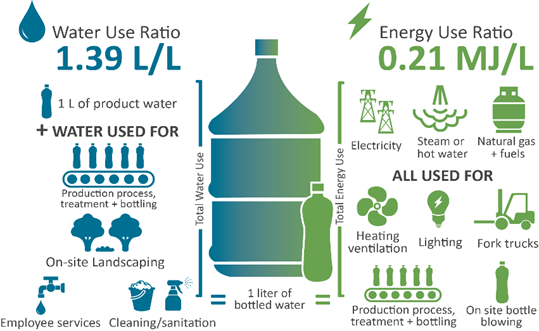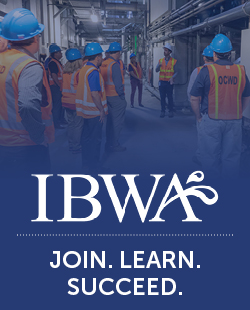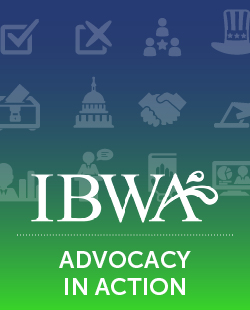Bottled Water & Water Use
Bottled Water & Water Use
Bottled water has the lowest water use and energy use ratios of any packaged beverage.

The bottled water industry is a very efficient water user
Overall sales growth and consumption of bottled water has increased, making bottled water the No.1 packaged beverage (by volume) in the United States. Although more consumers are choosing water over less healthy, sugar-sweetened beverages, bottled water still has the smallest water and energy footprint of any packaged beverage. The results of a 2018 IBWA Water and Energy Use Study show that the amount of water and energy used to produce bottled water products in North America is less than all other types of packaged beverages. On average, only 1.39 liters of water (including the 1 liter of water consumed) and 0.21 mega joules of energy are used to produce 1 liter of finished bottled water.
What is the Earth’s “water cycle”?
The water cycle, also known as the hydrologic cycle, describes the continuous movement of water as it makes a circuit from the oceans to the atmosphere to the Earth and on again.
Most of Earth’s water is in the oceans. The sun, which drives the water cycle, heats water in the oceans. Some of it evaporates as vapor into the air. Rising vapor cools and condenses into clouds. Cloud particles grow and fall out of the sky as precipitation.
Some precipitation accumulates as ice caps, glaciers, and snowpacks; in warmer climates, snow melts in the spring and flows into streams. Most precipitation falls back into the oceans or onto land, where it flows over the ground as surface runoff. A portion of runoff enters rivers and continues toward the oceans. Runoff and groundwater seepage can also accumulate and get stored as freshwater in lakes.
Some runoff soaks into the ground where it replenishes groundwater aquifers or seeps back to the surface.
Over time, this cycle continues again and again. (Source: USGS)

How much water is withdrawn in the United States for bottled water production?
According to the USGS, annual production of bottled water accounts for less than 0.02 percent of total groundwater withdrawn in the United States each year. In addition, bottled water has the lowest water use ratio of any packaged beverage. Even though it is a minimal groundwater user and is only one of among thousands of food, beverage, and commercial water users, the bottled water industry actively supports comprehensive groundwater management policies that are science-based, multi-jurisdictional, treat all users equitably, and provide for future needs of this important resource.
The following types of bottled water have groundwater sources:
- Spring Water – water derived from an underground formation from which water flows naturally to the surface of the earth.
- Artesian Water/Artesian Well Water – water from a well that taps a confined aquifer (a water-bearing underground layer of rock or sand) in which the water level stands at some height above the top of the aquifer.
- Well Water – is water from a hole bored, drilled, or otherwise constructed in the ground, which taps the water aquifer.
- Mineral Water – natural water containing not less than 250 parts per million total dissolved solids
- Sparkling Bottled Water – water that, after treatment and possible replacement with carbon dioxide, contains the same amount of carbon dioxide that is had as it emerged from the source.
The following water has a municipal water source:
- Purified Water – water that has been produced by distillation, deionization, reverse osmosis, or other suitable processes while meeting the definition of purified water in the U.S. Pharmacopoeia. If a bottled water product’s source is a municipal water system and the finished bottled water product does not meet the FDA Standard of Identity for purified water, the product label must disclose the public water system source.


